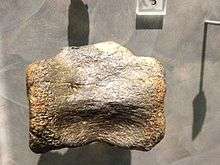Hypsibema
| Hypsibema Temporal range: Late Cretaceous | |
|---|---|
 | |
| H. crassicauda vertebra from North Carolina. | |
| Scientific classification | |
| Kingdom: | Animalia |
| Phylum: | Chordata |
| Class: | Sauropsida |
| Superorder: | Dinosauria |
| Order: | Ornithischia |
| Suborder: | Ornithopoda |
| Infraorder: | Iguanodontia |
| Superfamily: | Hadrosauroidea |
| Genus: | Hypsibema Cope, 1869 |
| Type species | |
| †Hypsibema crassicauda Cope, 1869 | |
| Species | |
| |
| Synonyms | |
|
Neosaurus Gilmore & Stewart, 1945 (preoccupied) | |
Hypsibema is a little-known genus of dinosaur from the Late Cretaceous (Campanian stage, around 75 million years ago). Its giant fossils were found in the U.S. states of North Carolina and Missouri. It is believed to be a hadrosaur, although the Missouri remains were first thought to belong to a small sauropod ("Neosaurus", renamed Parrosaurus).
The type species, Hypsibema crassicauda, was described by Edward Drinker Cope in 1869.[1] The generic name is derived from Greek υψι/hypsi, "high", and βεμα/bema, "step", as Cope believed that the species walked particularly erect on its toes. The specific name means "with a fat tail" in Latin. The holotype, USNM 7189, consists of a caudal vertebra, a humerus, a tibia and a metatarsal, found in 1869 by North Carolina state geologist professor Washington Carruthers Kerr in the King James marl pits. A second vertebra referred to the species, USNM 6136, was later discovered by Edward Wilber Berry.
A second species, H. missouriensis, named by Donald Baird and Jack Horner in 1979 (previously Parrosaurus missouriensis Gilmore 1945),[2] is since 2004 the official state dinosaur of Missouri.[3] Its holotype is USNM 16735, a set of vertebrae.
See also
Notes
- ↑ E.D. Cope, 1869, "Remarks on Eschrichtius polyporus, Hypsibema crassicauda, Hadrosaurus tripos, and Polydectes biturgidus", Proceedings of the Academy of Natural Sciences of Philadelphia 21: 191-192
- ↑ D. Baird and J. R. Horner, 1979, "Cretaceous dinosaurs of North Carolina", Brimleyana 2: 1-28
- ↑ "Archived copy". Archived from the original on May 28, 2013. Retrieved July 10, 2013.